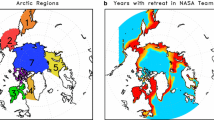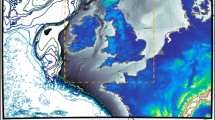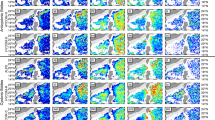Summary
The nudging assimilation scheme described in the companion paper by Brill et al. is applied to study oceanic cyclogenesis during GALEIOP 10 on 27–28 February 1986. A 36-h control simulation statically initialized from 0000 UTC 27 February 1986 data moves the cyclone too far north and east in the 12-h period of most rapid deepening limiting the usefulness of the simulation for diagnostic study. The use of nudging to dynamically assimilate special 3-h and routine 12-h rawindsonde and dropsonde data into the model during the entire 36-h forecast period failed to deepen the cyclone as it moved northeast off the Atlantic seaboard beyond the area covered 3-h by sounding data. Subjectively analyzed mean sea-level pressures (MSLP) were included in the data base to allow the model to nudge toward 3-h surface pressure analyses extended to cover the region of cyclogenesis over the ocean. The assimilation of 3-h surface data over the ocean is insufficient to produce a realistic simulation of cyclogenesis. This result motivated the use of the nudging technique to assimilate surface pressure and upper air data over land during the 12-h pre-cyclogenetic period (i.e. dynamic initialization) and compare the subsequent 24-h simulation with one initialized statically at the same synoptic time.
Dynamic initialization produced the best simulation of the occanic cyclone based upon the standard statistical scores and positions of the MSLP minima. This simulation is used to diagnose differences between cyclogenesis during GALEIOP 1 and IOP 10. Isentropic analyses and vertical cross sections are derived from the model simulations and are used to contrast the strength of the upper tropospheric forcing and the low-level static stability associated with each case. The results of the diagnostic analyses reveal that stronger surface response (based upon MSLP minima) to weaker upper-level forcing during GALEIOP 10 (compared with GALEIOP 1) was associated with differences in the lower tropospheric static stability and thermal advection patterns and their interaction with upper tropospheric features.
Similar content being viewed by others
References
Anderson, R. K., Ashman, J. P., Bittner, F., Farr, G. R., Ferguson, E. W., Oliver, V. J., Smith, A. H., 1969: Application of meteorological satellite data in analysis and forecasting. ESSA Tech. Rep. NESC 51. Government Printing Office, Washington, D.C. [NTIS AD-697033].
Anthes, R. A., 1974: Data assimilation and initialization of hurricane prediction models.J. Atmos. Sci.,31, 702–719.
Brill, K. F., Uccellini, L. W., Manobianco, J., Homan, J. H., Kocin, P. J., 1991: The use of successive dynamic initialization by nudging to simulate cyclogenesis during GALEIOP 1.Meteorol. Atmos. Phys.,45, 15–40.
Chen, S. J., Dell'Osso, L., 1987: A numerical case study of East Asian coastal cyclogenesis.Mon. Wea. Rev.,115, 447–487.
Dirks, R. A., Kuettner, J. P., Moore, J. A., 1988: Genesis of Atlantic Lows Experiment (GALE): An Overview.Bull. Amer. Meteor. Soc.,69, 148–160.
Duffy, D. G., Atlas, R., 1986: The impact of Seasat-A scatterometer data on the numerical prediction of the Queen Elizabeth II storm.J. Geophys. Res.,91, 2241–2248.
Hoke, J. E., Anthes, R. A., 1976: The initialization of numerical models by a dynamic-initialization technique.Mon. Wea. Rev.,104, 1551–1556.
Hoskins, B. J., McIntyre, M. E., Robertson, A. W., 1985: On the use and significance of isentropic potential vorticity maps.Quart. J. Roy. Meteor. Soc.,111, 877–946.
Kaplan, M. L., Zack, J. W., Wong, V. C., Tuccillo, J. J., 1982: Initial results from a mesoscale atmospheric simulation system and comparison with the AVE-SESAMEI data set.Mon. Wea. Rev.,110, 1564–1590.
Keyser, D., Uccellini, L. W., 1987: Regional models: Emerging research tools for synoptic meteorologists.Bull. Amer. Meteor. Soc.,68, 306–320.
Krishnamurti, T. N., Bedi, H. S., Heckley, W., Ingles, K., 1988. Reduction of spinup time for evaporation and precipitation in a spectral model.Mon. Wea. Rev.,116, 907–920.
Kuo, H. L., 1974: Further studies of the parameterization of the influence of cumulus convection on the large-scale flow.J. Atmos. Sci.,31, 1232–1240.
Kuo, H. L., Reed, R. J., 1988: Numerical simulation of an explosively deepening cyclone in the eastern Pacific.Mon. Wea. Rev.,116, 2081–2105.
Liou, C. S., Elsberry, R., 1987: Heat budgets of analyses and forecasts of an explosively deepning maritime cyclone.Mon. Wea. Rev.,115, 1809–1824.
Manobianco, J., 1989: Explosive east coast cyclogenesis over the west-central north Atlantic ocean: A composite study derived from ECMWF operational analyses.Mon. Wea. Rev.,117, 2365–2386.
Molinari, J., 1982: A method for calculating the effects of deep convection in numerical models.Mon. Wea. Rev.,110, 1527–1534.
Mullen, S. L., Baumhefner, D. P., 1988: Sensitivity of numerical simulations of explosive oceanic cyclogenesis to changes in physical parameterizations.Mon. Wea. Rev.,116, 2289–2329.
Nuss, W. A., Anthes, R. A., 1987: A numerical investigation of low-level processes in rapid cyclogenesis.Mon. Wea. Rev.,115, 2728–2743.
Peterson, R. A., 1986: Detailed three-dimensional isentropic analysis using an objective cross-sectional approach.Mon. Wea. Rev.,114, 719–735.
Ramamurthy, M. K., Carr, F. H., 1987: Four-dimensional data assimilation in the monsoon region. Part 1: Experiments with wind data.Mon. Wea. Rev.,115, 1678–1706.
Reed, R. J., 1955: A study of a characteristic type of upperlevel frontogenesis.J. Meteor.,12, 266–237.
Reed, R. J., 1955: Fronts in the vicinity of the tropopause.Arch. met. Geoph. Biocl., Ser. A,11, 1–17.
Rocbber, P. J., 1989: The role of surface heat and moisture fluxes associated with large scale ocean current meanders in maritime cyclogenesis.Mon. Wea. Rev.,117, 1676–1694.
Sanders, F., 1971: Analytic solutions of the nonlinear omega and vorticity equation for a structurally simple model of disturbances in the baroclinic westerlies.Mon. Wea. Rev.,99, 393–407.
Staley, D. O., Gall, R. L., 1977: On the wavelength of maximum baroclinic instability.J. Atmos. Sci.,34, 1679–1688.
Sutcliff, R. C., Forsdyke, G., 1950: The theory and use of upper air thickness patterns in forecasting.Quart. J. Roy. Meteor. Soc.,76, 189–217.
Teweles S., Jr., Wobus, H. B., 1954: Verification of prognostic charts.Bull. Amer. Meteor. Soc.,35, 455–463.
Uccellini, L. W., Keyser, D., Brill, K. F., Wash, C. H., 1985: The Presidents Day cyclone of 18–19 February 1979: Synoptic overview and analysis of the subtropical jet streak influencing the pre-cyclogenetic period.Mon. Wea. Rev.,112, 31–55.
Uccellini, L. W., Peterson, R. A., Brill, K. F., Kocin, P. J., Tuccillo, J. J., 1987: Synergistic interactions between an upper-level streak and diabatic processes that influence the development of a low-level jet and secondary coastal cyclone.Mon. Wea. Rev.,115, 2227–2261.
Uccellini, L. W., 1990: Processes contributing to the rapid development of extratropical cyclones. In: Newton, C. W. (ed.)Extratropical Cyclones, Palmen Memorial Volume. American Meteorological Society, 122–153.
Wash, C. H., Peak, J. E., Calland, W. E., Cook, W. A., 1988: Diagnostic study of explosive cyclogenesis during FGGE.Mon. Wea. Rev.,116, 431–451.
Weng, H. Y., Barcilon, A., 1987: Favorable environments for explosive cyclogenesis in a modified two-layer Eady model.Tellus,39 A, 202–214.
Whitaker, J. S., Uccellini, L. W., Brill, K. F., 1988: A modelbased diagnostic study of the rapid development phase of the Presidents' Day cyclone.Mon. Wea. Rev.,116, 2337–2365.
Author information
Authors and Affiliations
Additional information
With 19 Figures
Rights and permissions
About this article
Cite this article
Manobianco, J., Uccellini, L.W., Brill, K.F. et al. Contrasting the impact of dynamic data assimilation on the numerical simulations of cyclogenesis during GALEIOP 10 and IOP 1. Meteorl. Atmos. Phys. 45, 41–63 (1991). https://doi.org/10.1007/BF01027474
Received:
Revised:
Issue Date:
DOI: https://doi.org/10.1007/BF01027474




